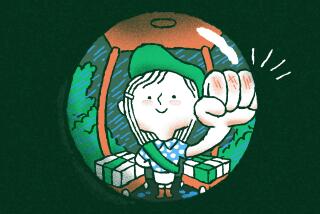Girl Scouts ‘Rough It’ to Begin a Diamond Jubilee
- Share via
The Girl Scouts threw a birthday party this weekend, and more than 13,000 people came.
To honor the 75th anniversary of Girl Scouting in the United States, the 10 Girl Scout councils of Southern California put together its Diamond Jubilee Roundup, which some say is the largest encampment of Girl Scouts ever held.
The grassy hills of Glen Helen Regional Park near San Bernardino were turned into a city of tents, complete with a field kitchen for 500, several open-air theaters, a daily newspaper, hundreds of portable “potties” and a fully staffed field hospital--but no showers, due to water-conservation restrictions--all managed with legendary Girl Scout efficiency.
The encampment was organized into 10 color-coded villages, and each girl was issued a hat and a wrist identification band in her village color. A computer system kept track of where each troop and leader could be found. Traffic patterns were smoothly managed by a team of high school-age, walkie-talkie-equipped Senior scouts, who were perched on a ridge above the parking area.
The organizing committee, which planned the event for two years, made certain that any girl who wanted to could participate: Sign-language interpreters were provided for the deaf, respirators for asthmatics and a special village catered to the disabled. For those who could not afford the $25-per-person fee, financial aid was available.
Girl Scouting began in 1912 when Juliette Gordon (Daisy) Low, a wealthy Savannah, Ga. widow, returned from a trip to England determined to create for girls an organization patterned on the British Boy Scouts, which was founded by her friend, Gen. Sir Robert Baden-Powell. Although the equivalent group for British girls was called the Girl Guides, Low, with typical independence of mind, rejected Baden-Powell’s insistence that “boys scout and girls guide ,” and named her new organization, numbering 36 girls, the Girl Scouts.
Within eight years, membership topped 50,000; in 1969, at the height of the baby boom, there were nearly 4 million Girl Scouts, and today there are almost 3 million, 200,000 of whom are in Southern California.
The weekend jubilee provided the girls with dozens of activities from which they could choose. Some listened to Pfc. Kerri Alland of Edwards Air Force Base, as she explained the mechanics of a UH-1H (“Huey”) helicopter. Others learned crafts, such as macrame and finger-weaving, practiced juggling, participated in sports, tried movie makeup techniques or created their own American sign language “name signs” with the help of former Miss Deaf America Margo Cienik. An exhibition of American Indian dances was extremely popular--perhaps because it was performed by Boy Scouts.
Each evening brought all 13,000 participants together; the featured attraction on Saturday night was folk singer Burl Ives, and on Sunday, Donny Osmond got top billing.
Each troop and leader went through a training program to participate in the jubilee.
“We’ve learned to lash, pitch tents and build fires,” said Doris Foster, leader of Cadette Troop 892 of Los Angeles, at their campsite in the Yellow Village.
‘We’ve had overnight camp outs in backyards, and drills on getting up on time. The girls complained, but we told them that if they weren’t up on time, they wouldn’t get any breakfast, and finally they believed us. Then they found out they had to fix their own breakfast!’
A large-scale event like this weekend’s is a once-in-a-lifetime experience for most scouts; the core of the Girl Scout program is based in neighborhoods. The majority of girls are in troops that meet after school with volunteer leaders, but in many areas, especially low-income and immigrant neighborhoods, leaders are difficult to find. In an attempt to involve more girls from those neighborhoods, the Angeles Girl Scout Council--which encompasses an area from the Santa Monica Mountains to San Pedro and the Pacific to East Los Angeles--has proven a national innovator by establishing drop-in Girl Scout Centers run by paid staff members.
More Than Baby Sitters
Some centers, funded by revenues from cookie sales, United Way and grants, are open daily during after-school hours; others, called “year-round” centers, are targeted for neighborhoods that have a year-round school calendar, where one-quarter of students are out of school at any given time--frequently without any other recreational activities available.
The centers, which serve about 2,000 of the 34,000 girls in the Angeles Council, “provide far more than child care,” according to Lynne L’Amoureux-Deshler, field services director for the council. “The girls do service projects, work on badges, go on field trips, go camping, sell cookies, participate in sports. It’s the whole Girl Scout program.”
A key element of Girl Scouting is to promote friendship between girls, according to Mary Spring of Canyon Country, a member of the national Board of Directors. Indeed, girls at the inner-city centers say “making friends” is their favorite part of Scouting, and at the encampment, the meeting and greeting went on at high speed all weekend. Before the jubilee, almost every girl made dozens of “swaps”--paper or fabric cutouts with name and address on the back, meant to be exchanged--and by midday Saturday, almost every hat was festooned with a collection of them.
After a closing ceremony this morning, the Girl Scouts will fold their tents and end the jubilee.
“A Girl Scout always leaves a place cleaner than she found it,” said Arlene Faber, a former president of the San Fernando Valley Girl Scout Council. “We’ve cleaned up the park so much since we got here. Believe me, when we leave, it won’t look like it did after they had the US Festival a few years ago.”
The volunteers around her nodded with pride.
More to Read
Sign up for Essential California
The most important California stories and recommendations in your inbox every morning.
You may occasionally receive promotional content from the Los Angeles Times.












